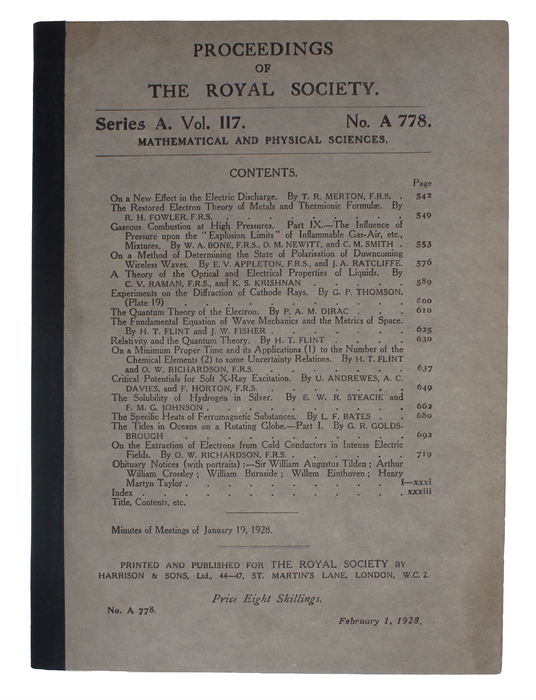FIRST ANNOUNCEMENT OF THE DIRAC EQUATION
DIRAC, PAUL.
The Quantum Theory of the Electron
London, Harrison and Sons, 1928.
Royal8vo. In the original printed wrappers. In "Proceedings of the Royal Society of London, Series A, Vol. 117, No. 778". Black cloth backstrip pasted on to spine, otherwise a fine copy (without institutional stamps). [Dirac's paper:]Pp 610-624. [Entire issue:] Pp. 541-730, (2), XXXVI, X + 6 plates.
First printing of Dirac's landmark paper in which he unified quantum mechanics and relativity and implied the existence of antimatter now known as the Dirac Equation; one of the great triumphs of theoretical physics which brought him on a par with the works of Newton, Maxwell, and Einstein before him. In 1933 he was awarded the Nobel Price in Physics "for the discovery of new productive forms of atomic theory", a direct consequence of the present paper. "[The Dirac Equations] ranks among the highest achievements of twentieth-century science" (Pais, Inward Bound, p. 290).
"In the Dirac equation not only quantum mechanics and the special theory of relativity were married, but also the spin of the electron is contained in it without any ad hoc assumption. But the equation not just beautifully described known phenomena, it did more. It predicted the existence of electrons with negative energy. This was at first held to be a severe problem of the theory but was finally understood as great progress, because negative-energy electrons could be interpreted as hitherto unknown particles. Thus, the existence of new particles was predicted which had all properties of the electron except for the electric charge. These particles were indeed found four years after the equation. Dirac is often quoted to have said that his equation 'contains most of physics and all of chemistry'." (Brandt, The Harvest of a Century).
"Even with the many successful applications of quantum mechanics to spectroscopy and other areas of physics, the theory was not without problems. There was, for example, the question of the relationship between relativity and quantum mechanics. If quantum mechanics was really a fundamental theory of the microcosmos, it ought to be consistent with the fundamental theory of macroscopic bodies, the (special) theory of relativity. Yet it was obvious from the very beginning that this was not the case. It was not too difficult to construct a relativistic quantum wave equation, such as Schrödinger had already done privately and as Oskar Klein, Walter Gordon, and several other physicists did in 1926-27. Unfortunately, this equation, known as the Klein-Gordon equation, did not result in the correct fine structure of hydrogen and it proved impossible to combine it with the spin theory that Pauli had proposed in 1927. The solution appeared in January 1928, when Dirac published his classical paper on 'The Quantum Theory of the Electron', which included a relativistic wave equation that automatically incorporated the correct spin. Dirac's equation was of the same general form as Schrödinger's equation [...] and included matrices with four rows and four columns; correspondingly the Dirac wave function had four components. Most remarkably, without introducing the spinning electron in advance, the equation contained the correct spin. In a certain, unhistorical sense, had spin not been discovered empirically, it would have turned up deductively from Dirac's theory. The new theory was quickly accepted when it turned out that the Dirac eigenvalue equation for a hydrogen atom resulted in exactly the same energy equation that Sommerfeld had derived in 1916. Dirac's relativistic wave equation marked the end of the pioneering and heroic phase of quantum mechanics, and also marked the beginning of a new phase" (Kragh, Quantum Generations, p. 167)
Order-nr.: 53720

